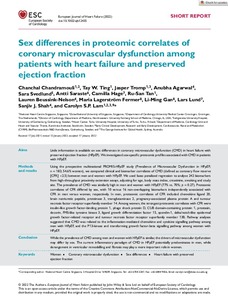Sex differences in proteomic correlates of coronary microvascular dysfunction among patients with heart failure and preserved ejection fraction
Agarwal Anubha; Svedlund Sara; Tromp Jasper; Ting Tay Wan; Fermer Maria Lagerstrom; Chandramouli Chanchal; Gan Li-Ming; Hage Camilla; Beussink-Nelson Lauren; Lam Carolyn S. P.; Lund Lars; Tan Ru-San; Shah Sanjiv J.; Saraste Antti
https://urn.fi/URN:NBN:fi-fe2022081154163
Tiivistelmä
Aims Little information is available on sex differences in coronary microvascular dysfunction (CMD) in heart failure with preserved ejection fraction (HFpEF). We investigated sex-specific proteomic profiles associated with CMD in patients with HFpEF.
Methods and results Using the prospective multinational PROMIS-HFpEF study (Prevalence of Microvascular Dysfunction in HFpEF; n = 182; 54.6% women), we compared clinical and biomarker correlates of CMD (defined as coronary flow reserve [CFR] <2.5) between men and women with HFpEF. We used lasso penalized regression to analyse 242 biomarkers from high-throughput proximity extension assays, adjusting for age, body mass index, creatinine, smoking and study site. The prevalence of CMD was similarly high in men and women with HFpEF (77% vs. 70%; p = 0.27). Proteomic correlates of CFR differed by sex, with 10 versus 16 non-overlapping biomarkers independently associated with CFR in men versus women, respectively. In men, proteomic correlates of CFR included chemokine ligand 20, brain natriuretic peptide, proteinase 3, transglutaminase 2, pregnancy-associated plasma protein A and tumour necrosis factor receptor superfamily member 14. Among women, the strongest proteomic correlates with CFR were insulin-like growth factor-binding protein 1, phage shock protein D, CUB domain-containing protein 1, prostasin, decorin, FMS-like tyrosine kinase 3, ligand growth differentiation factor 15, spondin-1, delta/notch-like epidermal growth factor-related receptor and tumour necrosis factor receptor superfamily member 13B. Pathway analyses suggested that CMD was related to the inflammation-mediated chemokine and cytokine signalling pathway among men with HFpEF, and the P13-kinase and transforming growth factor-beta signalling pathway among women with HFpEF.
Conclusion While the prevalence of CMD among men and women with HFpEF is similar, the drivers of microvascular dysfunction may differ by sex. The current inflammatory paradigm of CMD in HFpEF potentially predominates in men, while derangement in ventricular remodelling and fibrosis may play a more important role in women.
Kokoelmat
- Rinnakkaistallenteet [19207]
